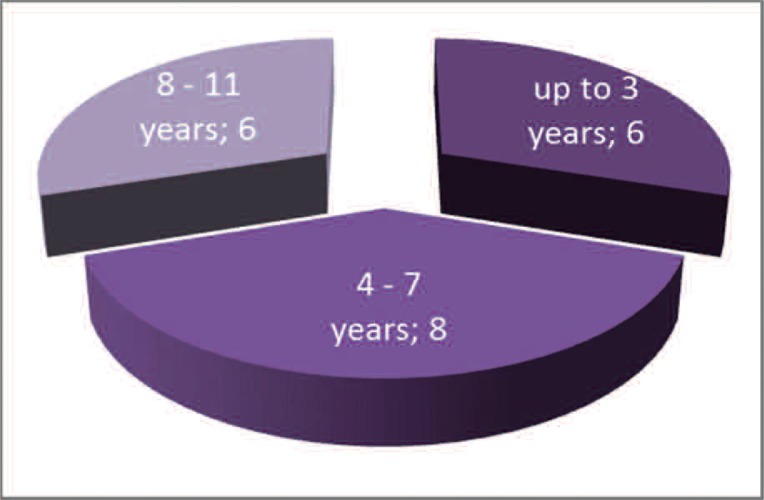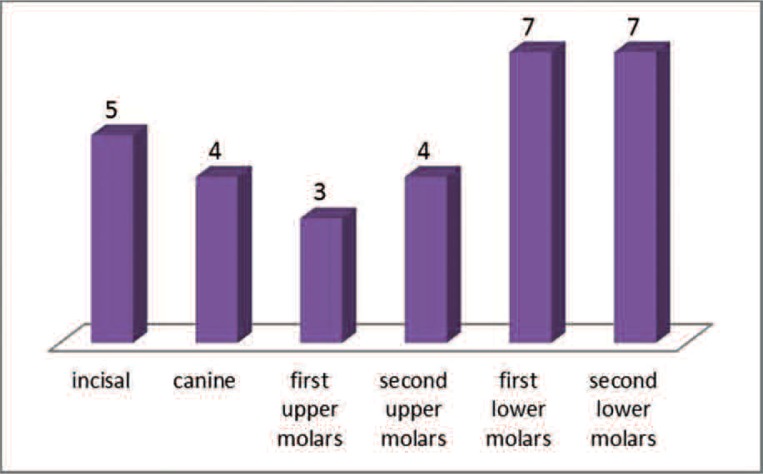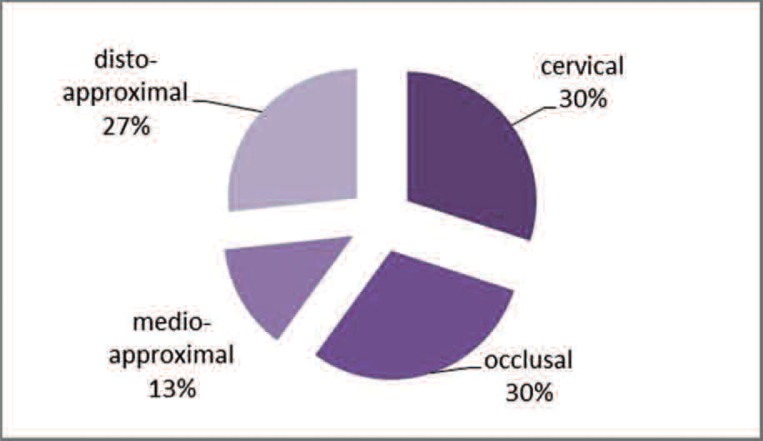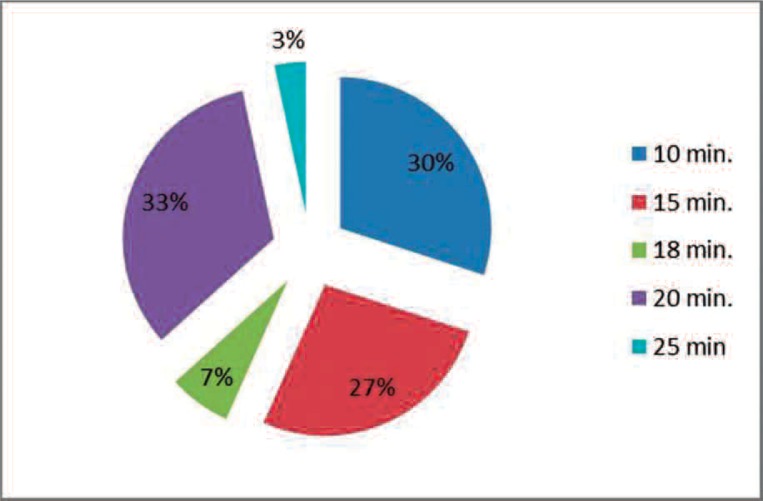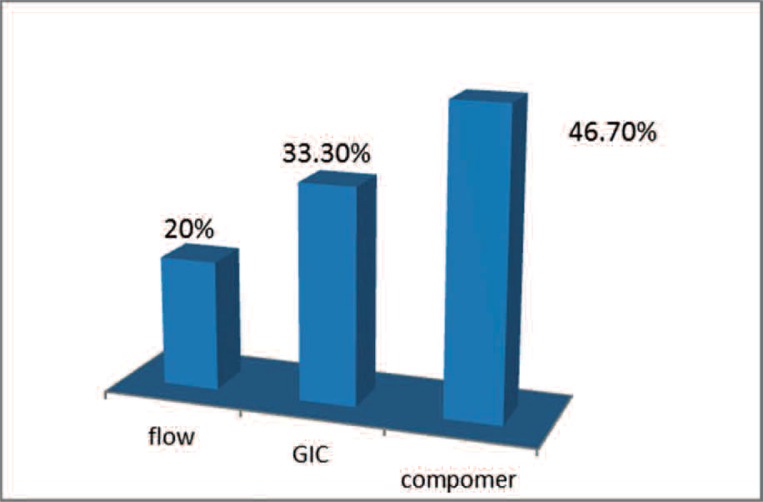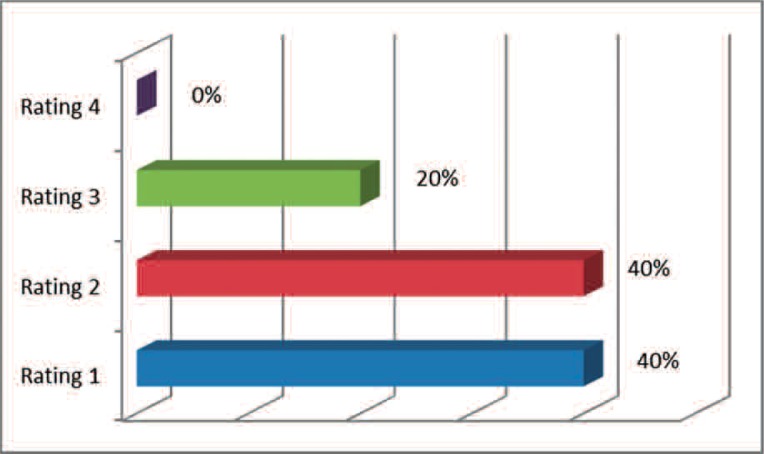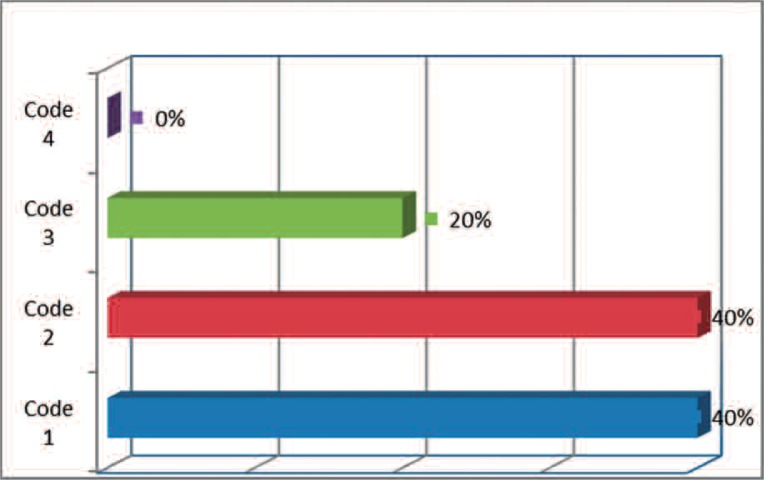Abstract
Introduction: Maintaining deciduous teeth as long as possible represents a goal in pediatric dentistry and avoids a plethora of health problems. Er:YAG carious decay treatment may help for prevention as well as during the curative processes.
Materials and Methods: An Er:YAG laser was used to ablate 30 carious lesions on primary teeth. Diagnosis being conventionally dressed, treatment was conducted in respect of the following parameters: Er:YAG laser (Lite Touch, Syneron): output power from 300 mJ (enamel) to 200 mJ (dentine), frequency 20 Hz, sapphire tip (diameter 1.3 mm), air water spray ratio 8 (39 ml/min), pulse duration 50 µsec., theoretical fluence ranging from 15.08 J/cm2 for dentin to 22.61 J/cm2 for enamel. Then cavity depth was controlled (observation + probe). Glass-ionomer cement (GC Fuji Triage capsule) or flowable composite resin or compomer were used to fill the cavities. Children's acceptance to Er-YAG laser treatment was evaluated. According to predefined criteria, each case was followed up for one month after treatment and then with further monthly follow-ups for one year.
Results: Clinical cases illustrate the validity of this clinical approach. The benefit of laser dental treatment has been shown to be the greatest in children. However, the lack of studies evaluating laser ablation capability in primary teeth restrains the adoption of this technology. The interaction between the Er:YAG laser and primary enamel and dentin depends on the composition of the tissues - a higher presence of water and lower presence of minerals- comparative to the permanent enamel and dentin. Thus, photoablation of primary enamel and dentin requires lower energy. This study shows that the laser parameters used (300 mJ/20 Hz for enamel and 200 mJ/20 Hz for dentin) are efficient enough for the ablation of tissues of deciduous teeth and moreover demonstrates to be well accepted by young patients.
Keywords: Pediatric dentistry, cavity preparation, Er-YAG laser, children, perception
Introduction
Modern dental medicine seeks to use an approach that is minimally invasive. Its aim is to prevent or detect dental caries and other diseases of the oral cavity in their initial stage in order to avoid or minimize invasive treatments. Minimally invasive caries treatment is based on four important modern concepts: early diagnosis, oral environment modeling based on caries risk evaluation, micro-invasive cavity preparation and dynamic treatment using biologically active materials and modern adhesive systems 1).
The new rules for cavity preparation in minimally invasive caries treatment require removing the bacterial infection and only those dental structures which are irreversibly decayed 2, 3, 4).
In recent years new technologies have been proposed as an alternative to the conventional mechanical removal of carious tissue. For a long period these methods used high-intensity lasers 5) and have been widely used and approved by professionals. A number of high-intensity lasers are able to remove carious tissue with minimal intervention 6, 7, 8, 9).
The Er:YAG laser wavelength (2940 nm) matches the absorption peak of water in the process of this wavelength's interaction with hard tissues. The energy is converted into heat, leading to water vapor formation, which expands and produces high pressure inside the target tissue and induces instantaneous micro-explosions and ejection of particles of tissue in a process called thermo-mechanical ablation 5).
The physical interaction of the Er:YAG laser with dental tissue has been shown to be an effective mechanism for the selective ablation of carious and healthy enamel and dentin in both primary and permanent teeth, despite the different water and mineral composition of these different substrates and different ablation thresholds of the various hard tissues 10).
The degree of mineralization of primary enamel is lower than that of permanent teeth, therefore its water content is higher and thus its energy absorption is higher, a fact which requires using different parameters in the ablation process in primary teeth as opposed to permanent teeth 7, 10).
It is therefore important to establish the proper energy and frequency of the Er:YAG laser that are specific to the substrates of primary teeth in order to establish protocols for laser cavity preparation and to create suitable approaches for different laser devices.
Aims:
The aims of this study were to assess:
1st objective: Evaluation of children's attitude to laser dental treatment
2nd objective: Determine the best method to use when removing dental caries using an Er:YAG laser
3rd objective: Proposal for a protocol for cavity preparation using Er:YAG laser
Materials and methods:
Twenty children between the age of 3 and 11 years participated in this study. Of these, 6 children were aged from 3- to 4, 8 children were aged from 4 to 8 and 6 children were aged from 8 to 11 (Fig. 1) Informed written consent was obtained from each patient's parents, as required by the institution's Ethics Board. All the procedures were conducted in accordance with the guidelines established by the Bulgarian Ministry of Health's Code of Bioethics for Dentists and the Helsinki Declaration.
Figure 1:
Patient distribution by age
Frankl's behavior rating scale was used to assess the behavior of all the children in the study group before treatment 11).
Class 1: child is completely uncooperative, crying, and it is very difficult to make any progress in treatment;
Class 2: child is uncooperative, very reluctant to listen or respond to questions, some progress in treatment is possible;
Class 3: child is cooperative, but somewhat reluctant or shy;
Class 4: child is completely cooperative and even enjoys the experience.
Children's attitudes to the relevant dental procedure were examined in a brief interview after the procedure. Responses are summarized in 4 groups:
Code 1 - child allows treatment using laser only after several visits of desensitization, after which the child's fear is overcome and the child becomes cooperative;
Code 2 - child allows dental treatment using laser only;
Code 3 - positive, shows interest in laser, which is supported by parents as well;
Code 4 - positive, conventional dental drills and laser are equally accepted.
Children's dental status was completely examined and medical records were taken, and a prevention program was drawn up.
Two independent operators examined the children. One dentist conducted the children's treatment. X-rays were not taken.
For cavity preparation we used an Er:YAG laser (Syneron, Lite Touch™, Israel) with the following parameters:
Energy ranging from 100 to 300 mJ,
Pulse repetition rate: 20 Hz,
Sapphire tip diameter: 1.3 mm, 1.0 mm,
Pulse duration: 50 µsec,
Theoretical fluence: 15.05 J/cm2 for the dentin, 22.61 J/cm2 for the enamel and 12.74 J/cm2 for cavities' edges beveling
Non contact mode-distance: 0.5 to 1.0 mm,
Air-water-spray cooling: 39 ml/min,
No local anesthetic was used either before or during the treatment.
The preparation of the cavities was limited to vaporizing the infected layer leaving the treated area with one uniform color only in the bottom of the cavity preparation, without any ablation of healthy tooth structure.
During cavity preparation, a chronometer was used to time each procedure.
Cavities were filled with a biologically active restoration material, either GIC (Triage GC), flowable composite resin (Gradia Direct Loflow GC), or compomer (Glasiosite Voco). In the deepest carious lesions, calcium hydroxide liner was used before placing one of these filling materials. Follow up was performed during a period of 1 year to evaluate post-operative sensitivity and possible complications.
In each case, each step during laser cavity preparation was recorded and analyzed. The statistical analysis was performed using the Pearson correlation coefficient.
Results
Five primary incisors, 4 canines, 7 upper primary molars and 14 lower primary molars cavities were prepared using Er:YAG (Fig. 2).
Figure 2:
Distribution of treated primary teeth
An analysis of the carious lesions according their location shows that 9 were in the cervical area, 12 proximal lesions and 9 occlusal lesions (Fig. 3). Thus, all three possible types of carious lesions were prepared using the laser.
Figure 3:
Location of carious lesion
Due to the extent of the carious lesions chosen to be treated, remineralization could not be expected and therefore those areas of decay had to be considered irreversible lesions. Six of the lesions were at the dentin-enamel junction and the remaining 24 in the second half of the dentin.
During cavity preparation using the Er:YAG laser, a chronometer was used to time each procedure. In 17 of the cases the duration of their preparation was 10–15 minutes. In all other 12 dentin caries cases the duration was up to 20 minutes and only in one case did the time required approach 25 minutes. The mean time for cavity preparation was 15.7 ± 4.46 minutes. The distribution is presented in Fig. 4.
Figure 4:
Duration of laser cavity preparation
The distribution of the filling materials used to restore the cavities prepared with the Er:YAG laser is presented in Fig. 5.
Figure 5:
Distribution of restorations according to the type of filling material
14 of the cavities were filled with compomer (Glasiosite Voco), 10 with biologically active restoration material (Triage GC) and 6 with flowable composite resin (Gradia Direct Loflow GC). In the deepest carious lesions, the restoration was preceded by a calcium hydroxide liner.
In order to examine the children's perception of their treatment with an Er:YAG laser, they were initially grouped according their attitude to dental treatment using the Frankl Scale (figure 6).
Figure 6:
Children's attitude (%) to dental treatment using the Frankl Scale
This graph shows that 2/3 of the children showed either a negative or strongly negative attitude to dental treatment in general (rating 3 and 4) and only 20% of the children demonstrated a slightly positive attitude (rating 2).
Although most of the children initially had a negative attitude to dental treatment in general, none of them had a negative attitude to laser treatment or would not allow the laser treatment at all. The distribution of children according their attitude (code 1 to 4) to laser treatment is shown in Fig. 7.
Figure 7:
Distribution of children according their attitude to laser treatment
Fig. 7 shows that all of the children had a positive attitude to laser treatment, and for two thirds of the children laser treatment was the option that gained their cooperation. Parents of children (from code 2 and code 3) were strongly supportive of laser treatment. In children with a positive attitude according the Frankl scale, conventional dental drills and laser were equally well accepted. Despite the small number of examined children, an inversely proportional correlation between the children's behavior in the dental office and their attitude to laser treatment was recorded. (Pearson correlation coefficient= 0.821; p<0.01). In other words, the more the child demonstrated an initially negative attitude to dental treatment, the greater the probability that the child would accept a laser as the only possibility for dental treatment (code 3 and code 4).
The treated teeth were followed up for a period of 1 year and during this period no adverse events were observed.
Discussion
The protocol we used for Er:YAG laser assisted caries treatment of primary teeth showed good results in terms of acceptance by both patients and parents and can be recommended in for use in a pediatric clinical practice. These results could be linked to specific energy parameters, which differed for enamel and dentin as follows:
Enamel treatment: the most effective energy level was 300 mJ/20 Hz, (theoretical fluence: 22.61 J/cm2). Preparing enamel requires the sapphire tip to be perpendicular to the occlusal surfaces (occlusal caries), perpendicular to the smooth vestibular surfaces (cervical caries), and with a 45° angle in case of proximal caries.
Dentin treatment: 200 mJ/20 Hz, (theoretical fluence: 15.08 J/cm2). In the case of class II cavities, the floor of the box is best treated using an approach at a 90° angle and the walls of the proximal box with angles ranging from 30° to 45°. The pulpal wall should be approached cautiously. Observing the rules for micro-invasive cavity preparation, calcium hydroxide liners should be applied to stimulate a possible remineralization of the affected dentin.
Moreover, the use of active filling materials such as glass ionomer restorative materials containing fluoride is recommended.
Finishing the periphery of the cavities with the laser at a lower energy setting (100 mJ/20 Hz, theoretical fluence: 12,74 J/cm2) and the angle between the laser beam and the enamel surface at 45° assures the regularization of the enamel prisms before acid etching 12).
We defined parameters for primary hard tissue ablation using an Er-YAG laser (Syneron, Lite Touch™, Israel) based on Scanning Electronic Microscope (SEM) and IR spectroscopy results 13) as follows: fluences ranging from 15 J/cm2 (dentine) to 22 J/cm2 for enamel, with a pulse duration of 50 µsec and pulse repetition rate ranging from 10 to 20 Hz.
Minimally invasive treatment with an Er:YAG laser depends on two main parameters:
Spot size diameter: decreasing the spot size diameter leads to an increase in the energy delivered to the target tissue (Fluence F= J/cm2)
Pulse repetition rate (Hz): the more the pulse repetition rate is increased, the greater the ablation rate.
It is well known that the degree of mineralization of primary enamel is lower than that of permanent teeth, therefore its water content is higher and thus its energy absorption is higher, a fact which requires using different parameters in the ablation process in primary teeth. Giusti suggests using high parameters of laser energy in order to reduce the ablation time, which is a worthwhile goal in treating children 14). Nevertheless, there should be an individually tailored approach in order to avoid negative results 15). Using higher repetition rates leads to the appearance of more cut enamel prisms, more loosely bound particles, more irregular cut surfaces and a decrease in the tissue removal selectivity]. With regard to the energy level used, increases in energy level lead to removal of proportionally more enamel 16).
In our SEM investigation 13), primary enamel patterns after use of the Er:YAG laser at a setting of 300 mJ/20 Hz showed relatively smooth surfaces without the removal of big particles of the enamel prisms, the morphology of the enamel prisms was preserved. An increase in the energy used resulted in more irregularities and fused areas. Similar findings were reported by other authors 17). They observed via SEM the primary enamel patterns resulting from the use of an Er:YAG laser with different parameters and hypothesize that the crater depth is a linear function of radiant exposure per pulse. As the energy increases, more water in the enamel is vaporized during the cavity preparation, promoting faster laser penetration per unit of time. The short duration of the procedure seems to be an important condition in pediatric caries treatment but it should be matched with the choice of the optimal energy parameters, thus avoiding possible negative effects of Er:YAG laser ablation.
SEM observation of dentin shows an irregular topography with opened dentinal tubules without a smear layer after the use of the Er:YAG laser set at 200 mJ/20 Hz. An increase in energy (300 mJ/20 Hz) leads to the formation of more scaly dentin surfaces and greater ablation of intertubular dentin, leaving the peritubular dentin with a protruded appearance. These data indicate that Er:YAG laser action is more intensive on substrates with a higher water content. Higher energy (400 mJ/20 Hz) use on primary dentin led to such negative effects as melting. Other authors 15, 16) reported a dentinal surface with greater dentinal tubule obliteration, larger gaps, and greater ablation of intertubular dentin in comparison with the peritubular dentin after applying higher energy.
The correct management of the aiming beam direction is very important in order to control the ablation process in enamel prisms and dentinal tubules, since the goal is to achieve minimally invasive cavity preparation by removing only full-destroyed dental structures and infected dentin.
Er:YAG laser finishing and beveling of the enamel edges with lower energy parameters (100 mJ/20 Hz and angle between the laser beam and the enamel surface at 45°) assures good adhesion of the restorative material and a microleakage-free interface 18, 19). The proper choice of restorative materials for primary teeth, such as GIC or compomers, is also a prerequisite for a good final restoration in Er:YAG laser-assisted caries treatment in primary teeth.
The psychological effect of Er:YAG laser-assisted caries treatment in children shows a good acceptance of the laser as a treatment tool. Our investigation shows that notwithstanding the prolonged duration of the laser procedure in some cases, the most apprehensive children prefer it to conventional cavity preparation.
Conclusion
Er:YAG laser cavity preparation allows minimally invasive treatment of dental caries and also shows excellent acceptance among both young children and their parents. The choice of optimal energy parameters is a requirement for successful laser caries treatment in pediatric dentistry.
References
- 1: Ericson D. The concept of minimally invasive dentistry. Dent Update 2007, 34(1):9-10,12-14,17-18. [DOI] [PubMed] [Google Scholar]
- 2: Peters MC, Mc Lean ME, Minimally invasive operative care. I. Minimal intervention and concepts for minimally invasive cavity preparation, J Adhes Dent, 2001, 3(1):7-16. [PubMed] [Google Scholar]
- 3: Peters MC, Mc Lean ME. Minimally invasive operative care. II. Contemporary techniques and materials. An overview. J Adhes Dent. 2001, 3(1):17-31. [PubMed] [Google Scholar]
- 4: Vitale M, Caprioglio C, Lasers in dentistry-Practical text book; Martina Ed, Bologna, 2010; 85-104. [Google Scholar]
- 5: Hibst R, Keller U. Experimental studies of applications of Er:YAG laser on dental hard substances. I. Measurment of the ablationa rate. Lasers Surg Med. 1989; 9:338-344. [DOI] [PubMed] [Google Scholar]
- 6: Gutknecht N, Franzen R, Vanweersch L, Lasers in pediatric dentistry: A Review. J Oral Laser Appl. 2005, 5:207-218. [Google Scholar]
- 7: Freitas P, Navaro R, Barros J, Eduardo C. The use of Er -YAG laser for cavity preparation: an SEM evaluation. Microsc Res Tech; 2007, 70(9):803-808. [DOI] [PubMed] [Google Scholar]
- 8: Kornblit R, Trapani D, Bossu M, Muller-Bolla M, Rocca JP, Polimeni A, The use of Er:YAG laser for caries removal in paediatric patients following Minimally invasive Dentistry concepts. Europ J of Paediatr Dent. 2009, 10(2):75-92. [PubMed] [Google Scholar]
- 9: Polimeni A, Kornblit R, Laser e Odontoiatria Pediatrica. 2012, Tu E. Or Ed, Torino, pp194. [Google Scholar]
- 10: Borsatto MC, Torres CP, Chinelatti MA, Pecora JD, Corona JA, Palma-Dibb RG. Effect of Er:YAG laser Parameters on Ablation Capacity and Morphology of Primary Enamel., Photomed. Laser. Surg, 2009, 27 (2):253-260. [DOI] [PubMed] [Google Scholar]
- 11: Sarath A, Rekka P, Muthu S, Prabhu U, Sivakumar U, Children's behaviour pattern and behaviour management techniques used in a structural post graduate dental programme. J Indian. Soc. Pedodont. Prev. dent. 2009, 27(1):22-26 [DOI] [PubMed] [Google Scholar]
- 12: Curti M, Rocca JP, Bertrand M, Nammour S, Morpho-structural aspects of Er:YAG prepared class V cavities., J Clin Laser Med Surg 2004, 22(2); 119-23. [DOI] [PubMed] [Google Scholar]
- 13: Zhegova G, Rashkova M, Effects of the different Er:YAG laser parameters on morphology of primary enamel; Med Oral Patol Oral Cir Bucal. 2012. May 1;17(Supplement1):S94, * 10.4317/medoral.17643593; Abstr.13-th World Congress for Laser Dentistry; 2012:88. [DOI] [Google Scholar]
- 14: Giusti J, Pinto L, Lizarelli R, Ablation rates and morphological patterns of deciduous tooth-enamel after Er:YAG Laser Irradiation: An in vitro study, J Oral Laser Appl., 2002, 2:159-164. [Google Scholar]
- 15: Delme K, De Moor R; Scanning Electron Microscopic evaluation of enamel and dentin surfaces after Er:YAG laser preparation and laser conditioning. Photomed Laser Surg. 2007, 25(5):393-401. [DOI] [PubMed] [Google Scholar]
- 16: Ortolan A. S. de Ol, Torres CP, Gomes-Silva JM, de Menezes-Oliveira MA, Pecora JD, Palma-Dibb RG, Borsatto MC, Effect of Erbium-Doped Yttrium Aluminium Garnet Laser Parameters on Ablation Capacity and Morphology of Primary Dentin. Photomed. Laser Surg 2009, 27(6):885-890. [DOI] [PubMed] [Google Scholar]
- 17: Camerlingo C, Lepore M, Gaeta GM, Riccio R, Riccio C, De Rosa A, De Rosa M. Er:YAG laser treatments on dentine surface: micro-Raman spectroscopy and SEM analysis. J Dent 2004, 32(5):399-405. [DOI] [PubMed] [Google Scholar]
- 18: Brulat N, Leforestier E, Rocca JP, Darque-Cerretti E, Bertrand MF. Shear bond strength of self-etching adhesive systems to Er:YAG laser-prepared dentine with and without pulpal pressure. Photomed Laser Surg. 2008, 26(6):579-583. [DOI] [PubMed] [Google Scholar]
- 19: Bertrand MF, Brulat N, Lazzarini V, Marcato G, Namour S, Rocca JP. Er:YAG laser cavity preparation and semi-direct composite resin restoration. A microleakege study. Photomed Laser Surg 2008, 26(5):473-477. [DOI] [PubMed] [Google Scholar]



